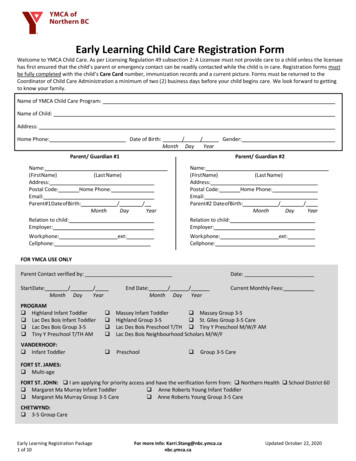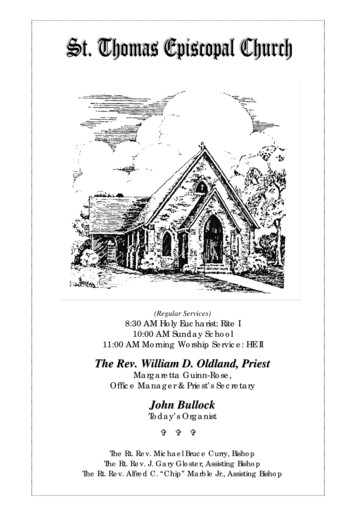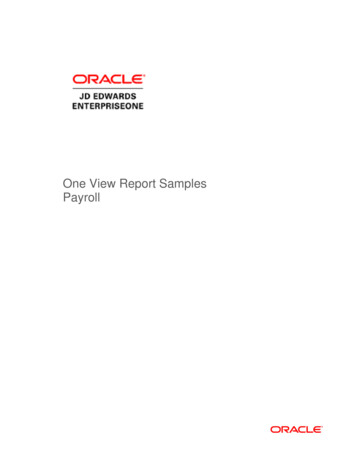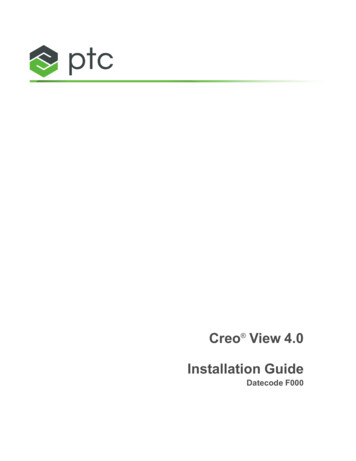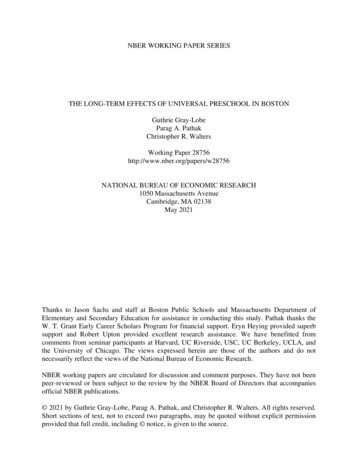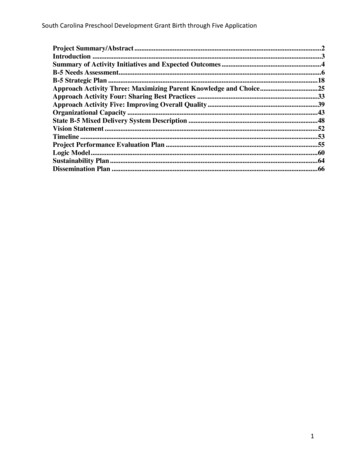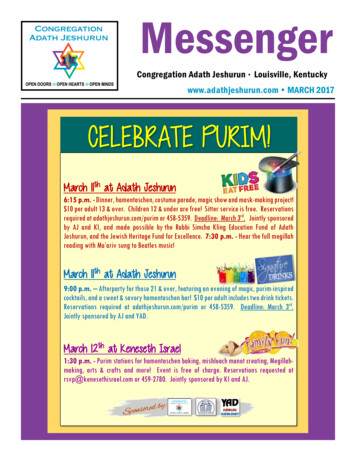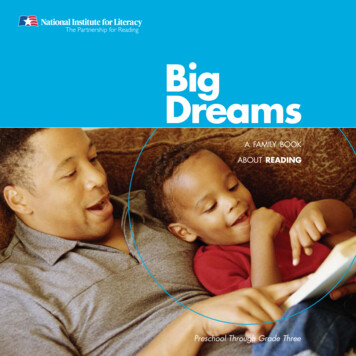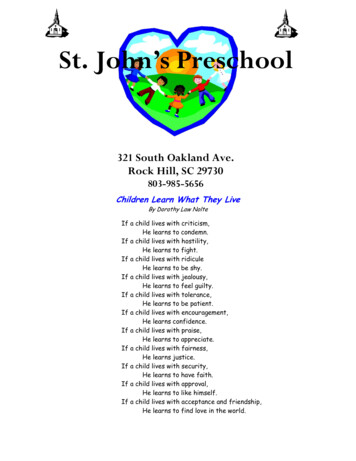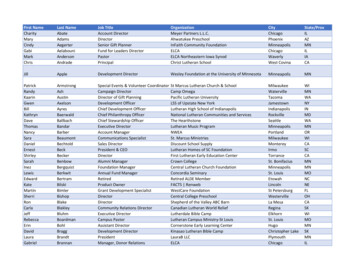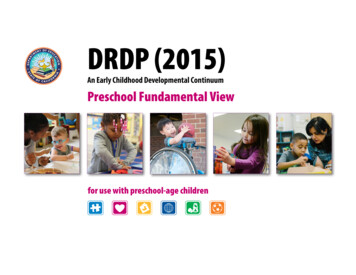
Transcription
DRDP (2015)An Early Childhood Developmental ContinuumPreschool Fundamental Viewfor use with preschool-age children
The DRDP (2015) was developed by the California Department of Education, Early Learning and CareDivision and Special Education Division, with assistance from:Berkeley Evaluation and Assessment Research Center, University of California, BerkeleyDesired Results Access Project, Napa County Office of EducationDesired Results Developmental Profiles (2015) Instrument and Research Studies Project, WestEd’s Center for Child and Family StudiesDesired Results Training and Technical Assistance Project, WestEd’s Center for Child and Family StudiesThe DRDP (2015) is available at the California Department of Education Website at www.cde.ca.gov/sp/cd/ci/drdpforms.aspFor more informationEarly Learning and Care Division Programs may contact:Desired Results Training and Technical Assistance ProjectWebsite: www.desiredresults.usEmail: desiredresults@desiredresults.wested.orgPhone: (800) 770-6339Special Education Division Programs may contact:Desired Results Access ProjectWebsite: www.draccess.orgEmail: info@draccess.orgPhone: (800) 673-9220 2013–2019 by the California Department of EducationAll Rights Reserved. Permission to reproduce only for instructional purposes.
DRDP (2015)An Early Childhood Developmental ContinuumPreschool Fundamental ViewFor use with preschool-age childrenTable of ContentsIntroduction to the DRDP (2015). . . . . . . . . . . . . . . . . . . . . . . . . . . . . . . . . . . . . . . . . . . . . . . . . . . . . . . . . . . . . . . . . . . . . . . .Information about Selected Key Features. . . . . . . . . . . . . . . . . . . . . . . . . . . . . . . . . . . . . . . . . . . . . . . . . . . . . . . . . . . .Guide to DRDP (2015) Views. . . . . . . . . . . . . . . . . . . . . . . . . . . . . . . . . . . . . . . . . . . . . . . . . . . . . . . . . . . . . . . . . . . . . . . .About the Measures of the DRDP (2015). . . . . . . . . . . . . . . . . . . . . . . . . . . . . . . . . . . . . . . . . . . . . . . . . . . . . . . . . . . . .Intro-1Intro-1Intro-2Intro-3The 3 Steps to Completing the DRDP (2015) . . . . . . . . . . . . . . . . . . . . . . . . . . . . . . . . . . . . . . . . . . . . . . . . . . . . . . . . . . . .Step 1: Observation and Documentation. . . . . . . . . . . . . . . . . . . . . . . . . . . . . . . . . . . . . . . . . . . . . . . . . . . . . . . . . . . .Step 2: Rating the Measures . . . . . . . . . . . . . . . . . . . . . . . . . . . . . . . . . . . . . . . . . . . . . . . . . . . . . . . . . . . . . . . . . . . . . . . .Step 3: Finalize the Assessment. . . . . . . . . . . . . . . . . . . . . . . . . . . . . . . . . . . . . . . . . . . . . . . . . . . . . . . . . . . . . . . . . . . . .Intro-6Intro-6Intro-7Intro-9Early Education Information Page . . . . . . . . . . . . . . . . . . . . . . . . . . . . . . . . . . . . . . . . . . . . . . . . . . . . . . . . . . . . . . . . . . . . . Intro-10Special Education Information Page. . . . . . . . . . . . . . . . . . . . . . . . . . . . . . . . . . . . . . . . . . . . . . . . . . . . . . . . . . . . . . . . . . . Intro-11Quick Guide to Rating the Measures. . . . . . . . . . . . . . . . . . . . . . . . . . . . . . . . . . . . . . . . . . . . . . . . . . . . . . . . . . . . . . . . . . . Intro-12Early Education PS Fundamental View Rating Record. . . . . . . . . . . . . . . . . . . . . . . . . . . . . . . . . . . . . . . . . . . . . . . . . . . Intro-13Special Education PS Fundamental View Rating Record. . . . . . . . . . . . . . . . . . . . . . . . . . . . . . . . . . . . . . . . . . . . Intro-15Summary of Measures in Preschool Views. . . . . . . . . . . . . . . . . . . . . . . . . . . . . . . . . . . . . . . . . . . . . . . . . . . . . . . . . . . . . . Intro-17Measures at-a-Glance. . . . . . . . . . . . . . . . . . . . . . . . . . . . . . . . . . . . . . . . . . . . . . . . . . . . . . . . . . . . . . . . . . . . . . . . . . . . . . . . . Intro-18Measures of the DRDP (2015). . . . . . . . . . . . . . . . . . . . . . . . . . . . . . . . . . . . . . . . . . . . . . . . . . . . . . . . . . . . . . . . . . . . . . . . . . . . . . . . 1Developmental Domain: ATL-REG — Approaches to Learning–Self-Regulation . . . . . . . . . . . . . . . . . . . . . . . . . . . . 1Developmental Domain: SED — Social and Emotional Development. . . . . . . . . . . . . . . . . . . . . . . . . . . . . . . . . . . . . . 8Developmental Domain: LLD — Language and Literacy Development. . . . . . . . . . . . . . . . . . . . . . . . . . . . . . . . . . . 13DRDP (2015): An Early Childhood Developmental Continuum – Preschool Fundamental View – June 24, 2019 2013–2019 California Department of Education – All rights reserved i of ii
Developmental Domain: ELD — English-Language Development. . . . . . . . . . . . . . . . . . . . . . . . . . . . . . . . . . . . . . . . 23Developmental Domain: COG — Cognition, Including Math and Science. . . . . . . . . . . . . . . . . . . . . . . . . . . . . . . . . 27Developmental Domain: PD-HLTH — Physical Development–Health. . . . . . . . . . . . . . . . . . . . . . . . . . . . . . . . . . . . . 34Glossary of Terms and Phrases Used in the DRDP (2015). . . . . . . . . . . . . . . . . . . . . . . . . . . . . . . . . . . . . . . . . . . . . . . . . . . . . 44Appendix A: Requirements of the DRDP (2015) Assessment . . . . . . . . . . . . . . . . . . . . . . . . . . . . . . . . . . . . . . . . . . . . . . . . . 46Appendix B: Resources for Assessing Children who are Dual Language Learners with the DRDP (2015). . . . . . . . 47Appendix C: Strategies for Observation and Documentation. . . . . . . . . . . . . . . . . . . . . . . . . . . . . . . . . . . . . . . . . . . . . . . . . 49Appendix D: Comprehensive Definitions of Adaptations to be Used with the DRDP (2015). . . . . . . . . . . . . . . . . . . . 51Appendix E: Resources for Working in Partnership with Families. . . . . . . . . . . . . . . . . . . . . . . . . . . . . . . . . . . . . . . . . . . . . 52Appendix F: Collaboration to Complete the DRDP (2015). . . . . . . . . . . . . . . . . . . . . . . . . . . . . . . . . . . . . . . . . . . . . . . . . . . . 54DRDP (2015): An Early Childhood Developmental Continuum – Preschool Fundamental View – June 24, 2019 2013–2019 California Department of Education – All rights reserved ii of 18
Introduction to the DRDP (2015)Information about Selected Key FeaturesWelcome to the Desired Results Developmental Profile (2015) [DRDP (2015)]:A Developmental Continuum from Early Infancy to Kindergarten Entry. The DRDP (2015) is aformative assessment instrument developed by the California Department of Education foryoung children and their families used to inform instruction and program development.Three of these key features: (1) consideration of young children who are dual languagelearners, (2) universal design and adaptations for children with IFSPs and IEPs, and (3) adetailed description of the developmental domains that make up the instrument, aredescribed in more detail to help teachers and service providers better understand and ratethe measures of the DRDP (2015).Young Dual Language Learners and the DRDP (2015)Key Features of the DRDP (2015): The DRDP (2015) is administered in natural settings through teacher observations,family observations, and examples of children’s work. Ongoing documentationof children’s knowledge and skills in everyday environments is a recommendedpractice for early childhood assessment. The DRDP(2015) represents a full continuum of development from early infancy upto kindergarten entry. The Infant/Toddler Views are for use with children in infant/toddler programs, and the Preschool Views, for children in preschool programs The DRDP (2015) is designed for use with all children from early infancy up tokindergarten entry, including children with Individualized Family Service Plans(IFSPs) and Individualized Education Programs (IEPs). The DRDP (2015) is aligned with all volumes of the California’s Infant/Toddler andPreschool Learning and Development Foundations, the Common Core Standards,and the Head Start Child Development and Early Learning Framework. The DRDP (2015) takes into consideration the specific cultural and linguisticcharacteristics of California’s diverse population of young children, with specificconsideration for children who are young dual language learners (see sectionbelow). The DRDP (2015) was developed with the goal of ensuring that all children havethe opportunity to demonstrate their knowledge and skills. To enable access tothe assessment for diverse populations, the principles of Universal Design werefollowed. The DRDP (2015) includes domains that meet the federal Office of SpecialEducation Programs (OSEP) child outcome reporting requirements for childrenwith Individualized Family Service Plans (IFSPs) or Individualized EducationPrograms (IEPs).DRDP (2015): An Early Childhood Developmental Continuum – Preschool Fundamental View – June 24, 2019Dual language learners are children learning two or more languages at the same time, aswell as those children learning a second language while continuing to develop their first(or home) language. A child’s experience with one or more languages is an asset to buildon in the early childhood setting. It is critical to consider the child’s communication in allthe languages that he or she is learning in order to have an accurate picture of a child’sknowledge and skills. Young children, including children with disabilities, can successfullylearn two or more languages. Learning two or more languages has linguistic, social,cognitive, academic, and cultural benefits. The path to learning one language shares manysimilarities with the path to learning two or more languages. There are also differences thatmust be taken into consideration when assessing young children who are dual languagelearners. Children may have vocabulary for concepts in one language and vocabularyfor other concepts in another language. So it is important to assess children in all of thelanguages he or she understands and uses. The DRDP (2015) addresses cultural andlinguistic responsiveness in two primary ways:1. Teachers and service providers observe and document children’s behavior in boththe home language and English to obtain a more accurate profile of the children’sknowledge and skills across developmental domains.2. Teachers and service providers rate children’s progress on two languagedevelopment domains. The Language and Literacy Development (LLD) domainassesses all children’s progress in developing foundational language and literacyskills where ratings should be based on skills in all languages. The English-LanguageDevelopment (ELD) domain assesses current knowledge and skills and progress inlearning to communicate in English.Universal Design and the DRDP (2015)In the context of assessment, “Universal Design” refers to the development of assessmentsthat are appropriate for all children to the greatest extent possible. Universal Designallows children the opportunity to demonstrate their knowledge and skills in a varietyof ways. All young children are entitled access to, and meaningful participation in, ageappropriate, individually-appropriate and culturally-appropriate early childhood curriculaand assessments. Teachers and service providers support children’s access and participationby identifying and providing learning opportunities, materials, and teaching strategies inflexible and individualized ways and through a variety of learning modalities. DRDP (2015)assessors apply universal design when they carefully consider the various ways youngchildren can demonstrate knowledge or skills that reflect mastery of a developmental level. 2013–2019 California Department of Education – All rights reservedIntro-1 of 18
Guide to DRDP (2015) ViewsEach view of the DRDP (2015) provides for the collection and reporting of valuableinformation about individual and group child developmental progress throughmeasurement of knowledge, skills, and behaviors. The views vary in the number ofmeasures that each include. When more measures are completed, the reports are morerobust and informative for teachers and providers, administrators, and agencies.DRDP (2015) ViewFocus and Intended UsersReports ProvidedInfant/Toddler andPreschool ComprehensiveViewThe Comprehensive views provide for assessmentof children’s learning and development in domainsrelated to all areas of the Infant/Toddler Learningand Development Foundations or Preschool LearningFoundations, covering the full range of learningand development that early childhood curriculagenerally cover. All programs may use the Comprehensive View. It is required for infants and toddlers withIndividualized Family Service Plans (IFSPs). It may be used for preschool-aged children withIndividualized Education Programs (IFSPs). Programs and providers may use the ComprehensiveView to earn points on the Quality Counts Californiarating matrix.Individual and groupreports on children’sdevelopmentalprogress acrossall domainsrelated to theFoundations. Meetsall requirements forspecial educationreporting.PreschoolFundamental ViewThe Fundamental view provides for assessment ofpreschool children’s learning and development in thekey domains associated with school readiness. All programs may use the Preschool FundamentalView. It may be used for preschool-age children withIndividualized Education Programs (IEPs). Programs and providers may use the FundamentalView to earn points on the Quality Counts Californiarating matrix.Individual and groupreports on children’sdevelopmentalprogress indomains associatedwith schoolreadiness. Meets allrequirements forspecial educationreporting.Infant/Toddler andPreschool Essential ViewThe Essential views provide for assessment of children’slearning and development with selected measures inkey domains. Programs and providers may use the Essential Viewto earn points on the Quality Counts Californiarating matrix.Individual and groupreports on children’sdevelopmentalprogress in subsets ofkey domains.DRDP (2015): An Early Childhood Developmental Continuum – Preschool Fundamental View – June 24, 2019 2013–2019 California Department of Education – All rights reservedIntro-2 of 18
The Eight Domains of the DRDP (2015)The DRDP (2015) is made up of eight domains. The focus of each domain is on theacquisition of knowledge, skills, or behaviors that reflect each domain’s developmentalconstructs.Approaches to Learning–Self-Regulation (ATL-REG)The ATL-REG domain assesses two related areas that are recognized as important for youngchildren’s school readiness and success: Approaches to Learning and Self-Regulation. Theseareas have been combined into one domain because of the strong connections betweenthem. The Approaches to Learning skills include attention maintenance, engagement andpersistence, and curiosity and initiative. The Self-Regulation skills include self-comforting,self-control of feelings and behavior, imitation, and shared use of space and materials.Social and Emotional Development (SED)The SED domain assesses children’s developing abilities to understand and interactwith others and to form positive relationships with nurturing adults and their peers. Theknowledge or skill areas in this domain include identity of self in relation to others, socialand emotional understanding, relationships and social interactions with familiar adults,relationships and interactions with peers, and symbolic and sociodramatic play.Language and Literacy Development (LLD)The LLD domain assesses the progress of all children in developing foundational languageand literacy skills. These skills can be demonstrated in any language and in any mode ofcommunication. Language and literacy skills in a child’s first language form the foundationfor learning English. Therefore, dual language learners may demonstrate knowledge andskills in their home language, in English, or in both languages. LLD measures should becompleted for all infants, toddlers, and preschool-age children, including those who aredual language learners.English-Language Development (ELD)The ELD domain assesses the progress of children who are dual language learners inlearning to communicate in English. The developmental progression described in the fourELD measures is related to the child’s experiences with English, not the child’s age. Keepin mind that children acquire English in different ways and at different rates. Factors thataffect English acquisition include degree of exposure to English, level of support providedin their home/first language, and individual differences such as age of exposure to Englishor the structure of the child’s home/first language. The ELD measures should be completedonly for preschool-age children whose home language is other than English.Cognition, Including Math and Science (COG)The COG domain focuses on observation, exploration of people and objects, andinvestigation of objects and concepts. The knowledge or skill areas in this domain includespatial relationships, cause and effect, classification, number sense of quantity, numbersense of math operations, measurement, patterning, shapes, inquiry through observationDRDP (2015): An Early Childhood Developmental Continuum – Preschool Fundamental View – June 24, 2019and investigation, documentation and communication of inquiry, and knowledge of thenatural world.Physical Development–Health (PD-HLTH)The PD-HLTH domain assesses motor development and the development of routinesrelated to personal care, safety, and nutrition. The knowledge or skill areas in this domaininclude perceptual-motor skills and movement concepts, gross locomotor movementskills, gross motor manipulative skills, fine motor manipulative skills, active physical play,nutrition, safety, and personal care routines (hygiene, feeding, dressing).History-Social Science (HSS)The HSS domain focuses on learning about the expectations of social situations, how toparticipate within a group, and the relationship between people and the environment inwhich they live. The knowledge or skill areas in this domain include sense of time, sense ofplace, ecology, conflict negotiation, and responsible conduct.Visual and Performing Arts (VPA)The VPA domain focuses on awareness and engagement in four areas of artistic expression.The knowledge or skill areas in this domain include visual art, music, drama, and dance.About the Measures of the DRDP (2015)The levels for each DRDP (2015) measure describe a developmental continuum, rangingfrom earlier developing to later developing competencies. The DRDP (2015) includes threetypes of continua: Full Continuum Measures: describe development from early infancy to earlykindergarten. These measures should be used with all infants, toddlers, andpreschool-age children. Earlier Development Measures: describe development that typically occurs fromearly infancy through early preschool ages and may be used with preschool-agechildren under specific conditions (identified as Conditional measures). Later Development Measures: describe development that typically occurs fromearly preschool ages to early kindergarten. These measures should be used with allpreschool-age children. 2013–2019 California Department of Education – All rights reservedIntro-3 of 18
Conditional Measures for Preschool-Age ChildrenSome measures in the DRDP Preschool Views are considered conditional measures thatare only assessed when certain conditions are met. These measures should be used ifthey assist teachers and service providers in planning a child’s learning activities andsupports, and documenting progress.Conditional measures are used in three instances: If a preschool child has not developmentally moved beyond the last level of thefour earlier-development measures. If a language other than English is spoken in the child’s home. If the child is still working on the health measures (required for all children withIEPs).Please note that the Earlier Development Measures, and the Physical Development andHealth measures are required for children with IEPs.Earlier Development MeasuresATL-REG 1: Attention MaintenanceATL-REG 2: Self-ComfortingATL-REG 3: ImitationCOG 1: Spatial RelationshipsEnglish-Language Development MeasuresELD 1: Comprehension of English (Receptive English)ELD 2: Self-Expression in English (Expressive English)ELD 3: Understanding and Response to EnglishLiteracy ActivitiesELD 4: Symbol, Letter, and Print Knowledge in EnglishPhysical Development and Health MeasuresPD-HLTH 5: SafetyPD-HLTH 6: Personal Care Routines: HygienePD-HLTH 7: Personal Care Routines: FeedingPD-HLTH 8: Personal Care Routines: DressingPD-HLTH 10: NutritionConditions Under Which to Assess Required for all preschool-age children with IEPs Recommended for a preschool-age child whosedevelopment is not beyond the latest developmental level If useful, select any or all of these four measures to assess In the Essential view for preschool-age children, measuresare not included.Conditions Under Which to Assess Used if a language other than English is spoken in thechild’s home as indicated on the Information Page Used only with preschool-age children Not used with children who are deaf or hard of hearingand not learning spoken language If rated, complete all of the measures in the ELD domain*Conditions Under Which to Assess In the Comprehensive view for preschool-age children,PD-HLTH 7 and 8 are conditional In the Fundamental view for preschool-age children,PD‑HLTH 5–8 and PD-HLTH 10 are conditional. In the Essential view for preschool-age children, measuresare not included Required for all preschool-age children with IEPs Recommended for preschool children when thisinformation would be useful for documenting progress orplanning this child’s learning activities and supports*Guidance for rating ELD measures for children who are dual language learners is provided in thesection, “Young Dual Language Learners and the DRDP (2015)” on page Intro-2.DRDP (2015): An Early Childhood Developmental Continuum – Preschool Fundamental View – June 24, 2019The Developmental LevelsThe number of levels in a measure varies depending on the competencies that areappropriate for that measure’s developmental continuum. The levels are organizedunder four categories from early infancy up to kindergarten entry: Responding,Exploring, Building, and Integrating:Responding (Earlier, Later)Knowledge, skills, or behaviors that develop from basic responses (through usingsenses and through actions) to differentiated responses. Children generally engage inback-and-forth interactions with familiar adults and communicate through nonverbalmessages.Exploring (Earlier, Middle, Later)Knowledge, skills, or behaviors that include active exploration including purposefulmovement, purposeful exploration and manipulation of objects, purposefulcommunication, and the beginnings of cooperation with adults and peers. Childrengenerally begin this period by using nonverbal means to communicate and, overtime, grow in their ability to communicate verbally or use other conventional forms oflanguage.Building (Earlier, Middle, Later)Knowledge, skills, or behaviors that demonstrate growing understanding of howpeople and objects relate to one another, how to investigate ideas, and how thingswork. Children use language to express thoughts and feelings, to learn specific earlyliteracy and numeracy skills, and to increasingly participate in small group interactionsand cooperative activities with others.Integrating (Earlier)Knowledge, skills, or behaviors that demonstrate the ability to connect and combinestrategies in order to express complex thoughts and feelings, solve multi-stepproblems, and participate in a wide range of activities that involve social-emotional,self-regulatory, cognitive, linguistic, and physical skills. Children begin to engage inmutually supportive relationships and interactions.Note that the developmental levels for the ELD domain differ from the above formatas they represent the developmental progression for the acquisition of English as asecond language during the early childhood years. 2013–2019 California Department of Education – All rights reservedIntro-4 of 18
Æ Example of an Earlier Developmental MeasureDefinitions of Terms in the Navigation MapsDevelopmental Domain: A crucial area of learning and development for children.Measure: The developmental continuum along which a child’s observed behavior isassessed. Measures are the individual assessment items in the DRDP. Full Continuum Measure: Describes development from early infancy to earlykindergarten. Early Development Measure: Describes development that typically occurs in infant/toddler and early preschool years. Later Development Measure: Describes development that typically occurs in thepreschool years and early kindergarten.Definition: Specifies the aspects of development to be observed.Developmental Level: A point along a developmental progression for a particularmeasure that ranges from earlier to later levels of development.Descriptor: Defines the behaviors that would be observed for a child at thatdevelopmental level.Example: Specific behaviors you might see that would demonstrate that a child hasreached mastery of a particular developmental level. Note that the examples provided inthe DRDP are not the only way a child can demonstrate mastery of a developmental level.Æ Example of a Full Continuum MeasureDRDP (2015): An Early Childhood Developmental Continuum – Preschool Fundamental View – June 24, 2019Æ Example of a Later Developmental Measure 2013–2019 California Department of Education – All rights reservedIntro-5 of 18
The 3 Steps to Completing the DRDP (2015)Step 1: Observation and DocumentationThe DRDP (2015) focuses on the child’s behavior, knowledge, and skills. To capture a child’sbehavior, the DRDP (2015) incorporates observation in natural settings.While observing and collecting documentation,remember that words, phrases, and sentencescan be communicated and understood in avariety of ways, including spoken in the child’shome language, signed, and through othercommunication modes (e.g., via a communicationdevice). The teacher’s and service provider’s directobservations of a child are the primary methodused to inform ratings and they should also useother sources of evidence to capture a morecomplete picture of a child’s knowledge and skills.Other sources of evidence include the following: Observations by others – includingteachers, family members/caregivers,and other service providers or caregivers,obtained through interview orconversationsObservations should occur overtime, in typical settings: In the child’s typicalprogram or settings suchas child care, classrooms,or home; As the child interacts infamiliar environments androutines with people he orshe knows; and As the child engagesin typical activities androutines. Other documentation – includingsamples of children’s work, photographs,and video/audio recordings of children’scommunication and behaviorYoung dual language learners may demonstrate knowledge and skills in their homelanguage, in English, or in both languages. They may also code-switch, which is usingmore than one language within a conversation. Therefore, communication in all languagesthe child uses should be considered when collecting documentation and completingthe measures in all domains. The adult who is conducting observations and collectingdocumentation should speak the child’s home language. If not, the adult must receiveassistance from another adult, who does speak the child’s home language. This may be anassistant teacher, director, parent, or other adult who knows the child.Dual Language Learners’ Use of Code Switching Code switching is the use of multiple languages within a single conversation. It is atypical feature of learning two or more languages. As early as three years of age, children code switch to playfully experiment with thetwo languages and to serve their own social and communication goals. For example,children may code switch to emphasize or elaborate a point. Children might code switch when speaking with one person, or may use onelanguage exclusively with one person and another language with another person. When children mix their two languages they use the grammatical rules of eachlanguage. For example, “I want leche” [“I want milk”] is an example of inserting aSpanish noun into a grammatically correct English sentence.Using AdaptationsThe Important Role of Families in the Documentation ProcessFamily members have repeated opportunities to observe their child’s activities andinteractions over time and in a variety of situations. Their perspectives, combined withteachers’ and service providers’ observations, provide a more complete and reliable pictureof a child’s typical behaviors. Inviting family members to share observations of theirchild’s development and behavior is a recommended practice for the DRDP (2015). Theopportunity to observe a child’s level of mastery is greatest when the child is interactingwith a familiar adult. Because of this, it is helpful to observe a child interacting withfamily members. This is especially true for children who are new to a program or at theearliest levels (Responding Earlier and Responding Later). These observations can informassessment decisions for all domains. They are particularly important for the SED and LLDdomains since social interaction and communication skills are learned through repeatedinteractions with familiar adults.DRDP (2015): An Early Childhood Developmental Continuum – Preschool Fundamental View – June 24, 2019Observation and Documentation for Young Dual Language LearnersAdaptations are changes in the environment or differences in observed behavior thatallow children with IFSPs or IEPs to demonstrate their knowledge and skills i
Intro-2 of 18. Guide to DRDP (2015) Views. Each view of the DRDP (2015) provides for the collection and reporting of valuable information about individual and group child developmental progress through
